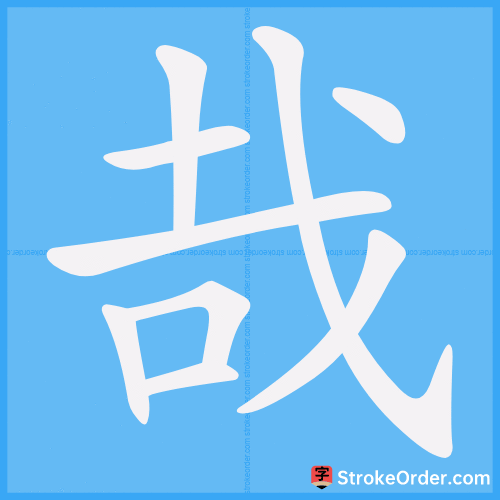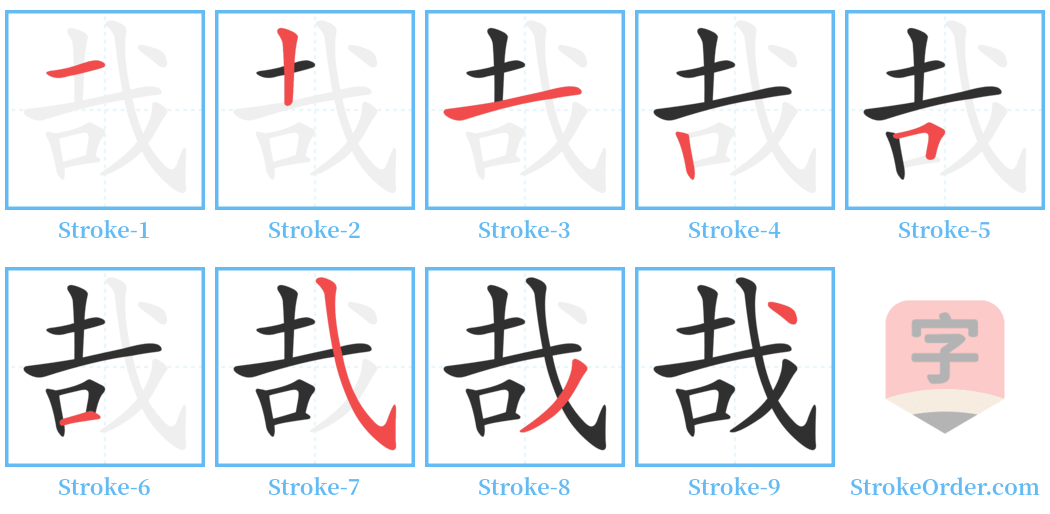哉 Stroke Order
Animated Stroke Order of 哉

Stroke Order Diagrams for 哉

Step-by-Step Handwriting Guide for 哉

Learn to Write Chinese Characters with Video Tutorials
Watch the video of writing the Chinese character "哉", learn the correct stroke order (笔顺) of the character "哉", and master the standard way of writing the character "哉".
Free Printable Handwriting Practice with Stroke Order: 哉
Printable Writing Practice Worksheet of "哉" in Portrait Orientation (Tian Zi Ge)

Printable Writing Practice Worksheet of "哉" in Landscape Orientation (Tian Zi Ge)

Information of 哉
Pinyin
zāi
Radical
口
Strokes
9 strokes
Usage
★★★★★
Definition
(exclamatory or interrog. part.)
哉 [zāi]
[助]
1. Classical Chinese particle indicating tone (1) expressing doubt or rhetorical questions, equivalent to "ma" or "ne," e.g., "何~?" (What is it?) "有何难~?" (What's so difficult about it?) (2) expressing exclamation, equivalent to "ah," e.g., "快~!" (So fast!)
2. Same as "才," meaning to begin.
【本义】: Tone particle. “When it is spoken, it is interstitial.” Indicates exclamation.
【造字法】: Phono-semantic compound.
【同义】:
1. Same as the original meaning ([En.] alas)
2. Indicates exclamation, equivalent to "ah."
3. Indicates affirmative tone, equivalent to "ah."
4. Indicates questions or rhetorical questions, equivalent to "ne" or "ma."
5. Indicates measurement, equivalent to "ba."
6. Indicates imperative tone, equivalent to "ba."
【引】
1. Cao Cao, "步出夏门行": 幸甚至哉。
2. "世说新语·方正": 非人哉。
3. Tang, Liu Zongyuan, "捕蛇者说": 旦旦有是哉。
4. "聊斋志异·狼三则": 变诈几何哉。
5. Qing, Liang Qichao, "饮冰室合集·文集": 美哉,我少年中国。
【例】
Again like: 远哉遥遥; 快哉此风; 命不易哉; 谁不为之痛心哉.
3. Indicates affirmative tone, equivalent to "ah."
【例】
For example: 敢不畏君王哉; 不若鸡犬哉.
4. Indicates questions or rhetorical questions, equivalent to "ne" or "ma."
【引】
1. "史记·陈涉世家": 安知鸿鹄之志哉.
2. Ming, Liu Ji, "郁离子·千里马篇": 岂独一琴哉.
3. "聊斋志异·促织": 岂主之子孙不必善哉.
4. Qing, Zhou Rong, "芋老人传": 岂独一箸间哉.
5. Qing, Peng Duanshu, "为学一首示子侄": 顾不如蜀鄙之僧哉? (哉, indicating rhetorical questions equivalent to "ma").
【例】
Again like: 以此为治,岂不难哉? 吾又何能为哉?
5. Indicates measurement, equivalent to "ba."
【引】
1. "书·尧典": 我其试哉!
【例】
Again like: 我岂有所失哉!
6. Indicates imperative tone, equivalent to "ba."
【引】
1. "诗·召南": 振振君子,归哉归哉!
Input Method for 哉
Pinyin
zai1
Wubi
fakd
Cangjie
jir
Zhengma
ehj
Four Corner
43650
Unicode
U+54c9